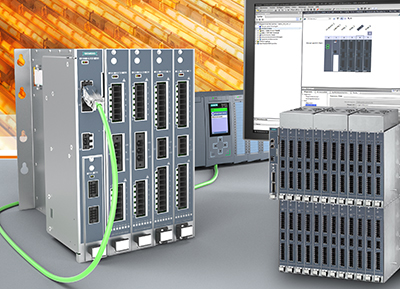Performance boost for industrial heating systems

- Significantly enhanced output power and power density for Siplus HCS heating control systems
- Siplus HCS4200 now also for very large heat emitter arrays with 230/277 V supply systems
- Siplus HCS4300 for four times as many heating elements as with previous 400/480 V line supplies
- Soft start function for heating elements with high inrush current
- Integrated into automation network via TIA Portal and Profinet/Profibus communication
Siemens has equipped its Siplus HCS modular heating control systems for switching and controlling heat emitter arrays and elements with considerably higher output power and power density. Siplus HCS4200 for 230/277 V power supply systems now has more than twice the number of outputs, for example.
With up to 384 outputs, an HCS4200 network can now control very large heat emitter arrays in the smallest of spaces. Additionally, the output power has been more than doubled with the new POM Midrange power output module – from 1.47 to 3.68 kilowatts per 230 V heating element.
This POM is also suitable for 277 V systems. The higher power density of the Siplus HCS4300 heating control system for 400/480 V systems now facilitates even more flexible modification to suit the application. With a maximum output of 7.6 kW per output and up to 216 outputs, this compact heating system can now control four times as many heating elements as previously.
Heating control systems from Siemens can be found in a range of sectors and applications all over the world, drying paint and coatings, for example, in the molding of plastics and lightweight construction materials, in plastic welding and in film extrusion. The new heating control systems promise to help plant operators cut their energy consumption by facilitating energy-efficient heating element actuation and avoiding current spikes in the network.
There are three new I/O modules available for Siplus HCS4200 and HCS4300 with practical supplementary functions: one for temperature detection, another with 16 digital inputs or outputs and a third for voltage and current measurements, which allows for compensation of line voltage fluctuations. The heating control systems have also been equipped with a soft start function, enabling emitters with extremely high inrush current up to 20 times the rated current to be controlled.
Via the TIA Portal (Totally Integrated Automation) engineering framework and Profinet/Profibus communication, the heating control systems are easy to integrate into the automation network comprising elements such as human machine interface (HMI) devices, controllers and motion control components. In the HCS program library, individual program blocks can easily be adapted to suit the application in question. Sample projects are available for first-time users.
Detailed diagnostic functions offer support in case of disturbances in the heating process and help to repair malfunctions quickly. It is possible to detect which emitter is defective, for example, whether an incoming or outgoing fuse has tripped or whether the line voltage or frequency is outside the tolerance range. The diagnostic data are reported to the central plant controller via Profinet/Profibus. For remote diagnostics, the user can access this data by means of a Web browser.
For further information, please see www.siemens.com/siplus-hcs
Siemens AG (Berlin and Munich) is a global technology powerhouse that has stood for engineering excellence, innovation, quality, reliability and internationality for more than 165 years. The company is active in more than 200 countries, focusing on the areas of electrification, automation and digitalization. One of the world's largest producers of energy-efficient, resource-saving technologies, Siemens is No. 1 in offshore wind turbine construction, a leading supplier of gas and steam turbines for power generation, a major provider of power transmission solutions and a pioneer in infrastructure solutions as well as automation, drive and software solutions for industry. The company is also a leading provider of medical imaging equipment – such as computed tomography and magnetic resonance imaging systems – and a leader in laboratory diagnostics as well as clinical IT. In fiscal 2014, which ended on September 30, 2014, Siemens generated revenue from continuing operations of €71.9 billion and net income of €5.5 billion. At the end of September 2014, the company had around 343,000 employees worldwide on a continuing basis.
Further information is available on the Internet at www.siemens.com
Reference Number: PR2015100010DFEN
Contact
Mr. Gerhard Stauss
Digital Factory Division
Siemens AG
Gleiwitzer Str. 555
90475 Nuremberg
Germany
Tel: +49 (911) 895-7945
gerhard.stauss@siemens.com
Media Contact
All latest news from the category: Trade Fair News
Newest articles

You are What You Eat—Stanford Study Links Fiber to Anti-Cancer Gene Modulation
The Fiber Gap: A Growing Concern in American Diets Fiber is well known to be an important part of a healthy diet, yet less than 10% of Americans eat the minimum recommended…

Trust Your Gut—RNA-Protein Discovery for Better Immunity
HIRI researchers uncover control mechanisms of polysaccharide utilization in Bacteroides thetaiotaomicron. Researchers at the Helmholtz Institute for RNA-based Infection Research (HIRI) and the Julius-Maximilians-Universität (JMU) in Würzburg have identified a…

ASXL1 Mutation: The Hidden Trigger Behind Blood Cancers and Inflammation
Scientists show how a mutated gene harms red and white blood cells. LA JOLLA, CA—Scientists at La Jolla Institute for Immunology (LJI) have discovered how a mutated gene kicks off…



